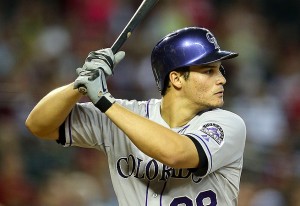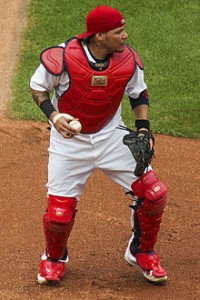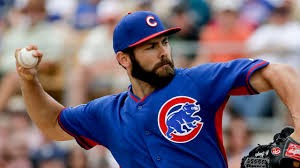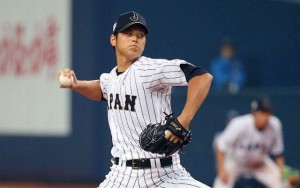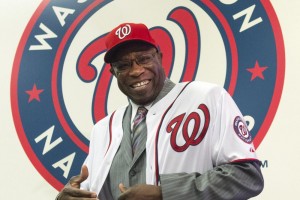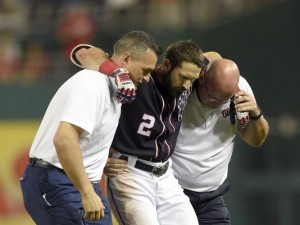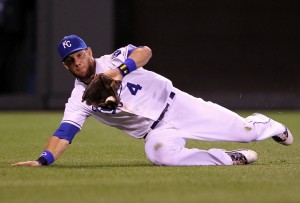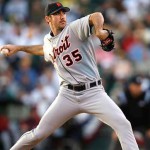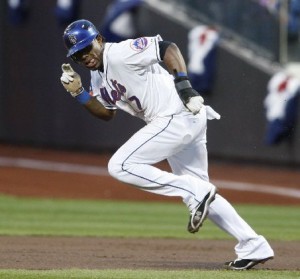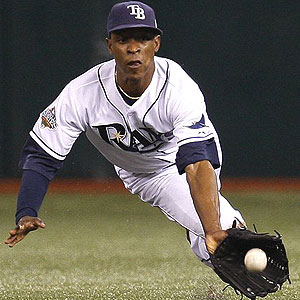
Conventional wisdom says the team will pursue BJ Upton. But what if there's a decent short-term alternative? Photo unknown via ajc.com
The Nats have not had a consistent, quality, and reliable center fielder since 2005 (and even then it was arguable). When the team moved here, Brad Wilkerson played most of the season in center field, put up a 103 ops+ and hit a bunch of homers while running around pre-game with packages of Skittles in his pocket. Jim Bowden traded Wilkerson with a couple other guys for one year of Alfonso Soriano. Since, then, here’s some of the guys who have played CF for us on a regular basis:
Preston Wilson
Endy Chavez
Ryan Church
Nook Logan
Marlon Byrd
Alex Escobar
Brandon Watson
Ryan Langerhans
Justin Maxwell
Brandon Watson
Lastings Milledge
Roger Bernadina
Elijah Dukes
Nyjer Morgan
Willie Harris
Corey Patterson
Half these guys are out of the league now, most of the rest are marginal players or backup outfielders. In 2011, we had innings from Rick Ankiel, Jayson Werth and even Laynce Nix (who managed to put in 8 innings in center field but somehow not have a single play, resulting in a neutral zero for UZR/150). But none of these guys is a long term CF solution, each for different reasons.
Is this the off season we end the madness and finally get a long term solution in center field?
I put together a spreadsheet of every Center Fielder option in the major leagues, threw in their age, salary, contract details, and three measures of their 2011 performance (OPS+, UZR/150 and bWAR). That spreadsheet is here, for reference. I’ll pull out the relevant details for each section below.
I’ve divided the CF options to consider into several categories below.
1. Current Washington CF options in-house
| Player |
Age |
Team |
Current Contract |
2011 Salary |
2011 OPS+ |
2011 UZR/150 CF only |
2011 bWAR |
| Bernadina, Roger |
27 |
Washington |
Pre-Arb |
$414,000 |
82 |
-16.6 |
0.8 |
| Werth, Jayson |
32 |
Washington |
7yr/$126M->2017 |
$10,571,000 |
97 |
3 |
2.1 |
Bernadina, despite his defensive reputation, was actually rather awful in CF this year while putting up an 82 OPS+. He’s now had more than a 1000 major league at-bats to show his worth. The team should DFA him and move on. Werth actually had a decent UZR/150 in center, albeit in a small sample size, hence why the team seems to be considering using him there on a more regular basis. We also have a couple of other internal options in the minors:
- Corey Brown: though his successful designation to AAA says more about his future than I could say. He’s gone from trade chip prospect to organizational guy in 2 seasons.
- Eury Perez: just ADDED to the 40-man, but more for protection purposes than because he’s ready. He’s an option perhaps in mid-season 2013.
- Bryce Harper: I’d love to see Harper groomed to play CF and don’t understand why the team hasn’t taken more of an effort to do so. His value as a power-hitting CF would far eclipse his value in a corner OF spot. As it stands now though, he’s not a full time CF and he probably won’t be on the MLB roster until late June, IF he earns it.
So, we could stand pat, use Werth primarily in CF and pursue a corner outfielder in free agency. But that still leaves a lead-off hole in our lineup and then probably also leaves a RF hole…
2. Franchise Players/Entrenched Starters/Longer Term Contract
| Player |
Age |
Team |
Current Contract |
2011 Salary |
2011 OPS+ |
2011 UZR/150 CF only |
2011 bWAR |
| Ellsbury, Jacoby |
27 |
Boston |
Arb 2nd yr |
$2,400,000 |
146 |
15.7 |
7.2 |
| Granderson, Curtis |
30 |
NY Yankees |
5yr/$30M->2012 |
$8,250,000 |
138 |
-5 |
5.2 |
| Hamilton, Josh |
30 |
Texas |
2yr/$24M->2012 |
$8,750,000 |
128 |
-3.3 |
3.6 |
| Jones, Adam |
25 |
Baltimore |
Arb 2nd yr |
$3,250,000 |
114 |
-8.5 |
1.7 |
| Kemp, Matt |
26 |
LA Dodgers |
8yr/$160M->2019 |
$7,100,000 |
171 |
-4.7 |
10 |
| McCutchen, Andrew |
24 |
Pittsburgh |
Arb 1st yr |
$452,500 |
127 |
3.3 |
5.5 |
| Pagan, Angel |
29 |
NY Mets |
Arb 4th yr |
$3,500,000 |
93 |
-16 |
0.2 |
| Victorino, Shane |
30 |
Philadelphia |
3yr/$22M->2012 |
$7,500,000 |
129 |
5.7 |
5.1 |
| Young, Chris |
27 |
Arizona |
5yr/$28M->2013 |
$5,200,000 |
103 |
12.9 |
4.8 |
For the most part this is a list of the best CFs in baseball. There’s almost no chance any of these teams are giving up these players in trade; they’re cornerstones, MVP candidates, or key players.
Angel Pagan isn’t a great CF, but he’s clearly the entrenched starter for the Mets, a team clearly in financial chaos. Likewise, perhaps someone like Adam Jones could be put into the “franchise player” category (he’s not nearly the player as the rest of these guys), but he’s also entrenched in Baltimore.
Coincidentally, look at Ellsbury‘s stats. Young, cheap, a 146 ops+, a 7.2war and a 15.7 UZR/150. Is there a more complete player in baseball right now? Matt Kemp certainly out hit him, but Ellsbury had the best UZR rating for any full time CFer in the majors while putting up his 30/30 season.
3. Recent Acquisitions
| Player |
Age |
Team |
Current Contract |
2011 Salary |
2011 OPS+ |
2011 UZR/150 CF only |
2011 bWAR |
| Bourn, Michael |
28 |
Atlanta |
Arb 3rd Yr |
$4,400,000 |
104 |
-6.2 |
5 |
| Cabrera, Melky |
26 |
San Francisco |
Arb 4th yr |
$1,250,000 |
121 |
-9.7 |
2.9 |
| Jackson, Austin |
24 |
Detroit |
Pre-Arb |
$440,000 |
89 |
8 |
2.4 |
| Rasmus, Colby |
24 |
Toronto |
Arb 1st year |
$443,000 |
89 |
-10.7 |
0.2 |
| Schafer, Jordan |
24 |
Houston |
Pre-Arb |
$414,000 |
74 |
-4.3 |
0.2 |
These guys aren’t necessarily the best CFs out there, but each of them was more or less just acquired, so presumably they’re not going anywhere ELSE this off-season. Schaefer just got busted for drug possession, and seems to be in competition with Jason Bourgeois (listed later on), but both really underperformed this year and are not really good options for the Nats.
4. Younger Starters and Up and coming prospects
| Player |
Age |
Team |
Current Contract |
2011 Salary |
2011 OPS+ |
2011 UZR/150 CF only |
2011 bWAR |
| Bourjos, Peter |
24 |
LA Angels |
Pre-Arb |
$414,000 |
115 |
8 |
5 |
| Cain, Lorenzo |
25 |
Kansas City |
Pre-Arb |
$414,000 |
73 |
-38.8 |
0.1 |
| Fowler, Dexter |
25 |
Colorado |
Arb 1st yr |
$424,000 |
105 |
-6.8 |
1.2 |
| Gomez, Carlos |
25 |
Milwaukee |
Arb 3rd Yr |
$1,500,000 |
82 |
27.5 |
1.7 |
| Jay, Jon |
26 |
St. Louis |
Pre-Arb |
$416,000 |
114 |
3.2 |
1.3 |
| Jennings, Desmond |
24 |
Tampa Bay |
Pre-Arb |
$414,000 |
128 |
-7.1 |
2.3 |
| Maybin, Cameron |
24 |
San Diego |
Pre-Arb |
$429,100 |
103 |
11.6 |
2.9 |
| Peterson, Brian |
25 |
Miami |
Pre-Arb |
$414,000 |
105 |
13 |
0.5 |
| Revere, Ben |
23 |
Minnesota |
Pre-Arb |
$414,000 |
73 |
15.1 |
0.8 |
| Stubbs, Drew |
26 |
Cincinnati |
Pre-Arb |
$450,000 |
86 |
-2.2 |
2.9 |
| Sweeney, Ryan |
26 |
Oakland |
Arb 2nd yr |
$1,400,000 |
91 |
-5.9 |
0.8 |
| Trout, Mike |
19 |
LA Angels |
Pre-Arb |
$414,000 |
88 |
0 |
0.9 |
This is a list of mostly 2nd tier CFers in this league, but for the most part they’re pre-arbitration or still relatively affordable, and teams aren’t about to give up on them. Peter Bourjos represents the Angel’s biggest problem in trying to find playing time next year for Mike Trout: he hits the ball well, he has great defense and he’s only 24. However the Angels are dying for a catcher, which just so happens to be a strength for this team. Bourjos mostly batted at the bottom of their order, but seems like a natural leadoff hitter.
I put Sweeney in this list only because the entire starting Oakland OF hit free agency, and they’ll need to start SOMEONE in the outfield in 2012. Lorenzo Cain looks set to be KC’s starter with the Cabrera trade, so I list him here despite his poor numbers in 2011 (besides that Kansas City isn’t exactly in a position to be trading away prospects right now). Peterson looks like he could take over for Miami in center (see further down for a discussion on this effect on Chris Coughlan).
Best possibilities: The Nats sacrifice a catcher and a decent prospect haul for Bourjos.
5. Awful Contracts/Poor players/Veterans not interested in
| Player |
Age |
Team |
Current Contract |
2011 Salary |
2011 OPS+ |
2011 UZR/150 CF only |
2011 bWAR |
| Davis, Rajai |
30 |
Toronto |
2yr/$5.75M->2012 |
$2,500,000 |
67 |
-17.5 |
-0.9 |
| Gutierrez, Franklin |
28 |
Seattle |
4yr/$20M->2013 |
$4,312,500 |
53 |
27.1 |
-0.4 |
| Hunter, Torii |
35 |
LA Angels |
5yr/$90M->2012 |
$18,000,000 |
115 |
-39.3 |
2.2 |
| Milledge, Lastings |
26 |
Chicago WS |
Arb 2nd yr |
$500,000 |
97 |
-82.2 |
-0.3 |
| Morgan, Nyjer |
30 |
Milwaukee |
Arb 1st year |
$450,000 |
111 |
13 |
2 |
| Rios, Alex |
30 |
Chicago WS |
6yr/$64M->2014 |
$12,500,000 |
65 |
-7.4 |
-1.5 |
The list above includes two Washington castoffs (Milledge and Morgan), one of the worst contacts in baseball (Rios), two severe under performers (Davis and Gutierrez), and a guy who really doesn’t play CF anymore (Hunter). There’s no appealing trade options here.
Ok. now that we’ve seen who is likely NOT going to be options for us in 2012, lets look at those that could be options.
1. Cleveland’s CF log jam
| Player |
Age |
Team |
Current Contract |
2011 Salary |
2011 OPS+ |
2011 UZR/150 CF only |
2011 bWAR |
| Brantley, Michael |
24 |
Cleveland |
Pre-Arb |
$421,800 |
96 |
-12.8 |
2.2 |
| Carrera, Ezequiel |
24 |
Cleveland |
Pre-arb |
$414,000 |
72 |
-1.5 |
-0.5 |
| Crowe, Trevor |
27 |
Cleveland |
Pre-arb |
$435,700 |
61 |
66.6 * |
-0.1 |
(Crowe’s 66.6 uzr/150 was a very small sample size and isn’t indicative one way or the other of his defensive prowness).
With Cleveland’s re-signing of Grady Sizemore to a one year incentive laden deal (guaranteed $5M, with $4M more in incentives), suddenly Cleveland has too many center fielders. Sizemore, Carrera and Bradley all played about equal numbers of innings in center for the team last year, with Crowe throwing in a few more. Brantley was essentially the starting left fielder but got 400-some innings in Center, and seems set to do the same this year with him and Sizemore switching back and forth. That leaves Carrera and Crowe as “extra” outfielders for the team. Crowe is a former 1st rounder who seems to have peaked as a 4-A guy, while Carrera just earned a callup for the first time in 2011. For now both look like nothing better than 4th outfielders, so we’re looking elsewhere.
Best possibilities here: none
2. Veteran Trade Possibilities
| Player |
Age |
Team |
Current Contract |
2011 Salary |
2011 OPS+ |
2011 UZR/150 CF only |
2011 bWAR |
| Borbon, Julio |
25 |
Texas |
Pre-Arb |
$490,000 |
72 |
-9.6 |
-0.3 |
| Bourgeois, Jason |
29 |
Houston |
Pre-Arb |
$423,000 |
89 |
-6.2 |
2.3 |
| Byrd, Marlon |
33 |
Chicago Cubs |
3yr/$15M->2012 |
$5,500,000 |
96 |
3.3 |
1.7 |
| Coghlan, Chris |
26 |
Miami |
Arb 1st yr |
$490,000 |
81 |
-12 |
-0.1 |
| Gardner, Brett |
27 |
NY Yankees |
Arb 1st yr |
$529,500 |
89 |
6.6 |
4.4 |
| Gentry, Craig |
27 |
Texas |
Pre-Arb |
$416,000 |
84 |
35 |
1.4 |
| Quenton, Carlos |
28 |
Chicago WS |
Arb 3rd Yr |
5,050,000 |
124 |
1.7 * |
3.2 |
| Span, Denard |
27 |
Minnesota |
5yr/$16.5M->2014 |
$1,000,000 |
91 |
17.6 |
2.6 |
| Torres, Andres |
33 |
San Francisco |
Arb 2nd yr |
$2,200,000 |
82 |
17.3 |
1.3 |
| Upton, BJ |
26 |
Tampa Bay |
Arb 3rd Yr |
$4,825,000 |
115 |
1.4 |
3.8 |
It is from this list that most of the current Nats trade rumors come. Here’s some thoughts, roughly in alphabetical order:
- Julio Bourbon seems like a potential non-tender for now: Endy Chavez got most of the CF innings for the team but Hamilton can cover it well enough (as he did in the playoffs). But they also have Craig Gentry. Neither is that great an offensive player, but Gentry is a pretty good defensive player. None of them solve our issues.
- Jason Bourgeois was mediocre both at the plate and in the field, and now Houston has acquired Schafer in trade, so he might be available in trade. But what does he bring that Bernadina doesn’t? We don’t need a replacement guy.
- Former Nat Marlon Byrd could be an interesting candidate; he wasn’t that bad in 2011, but is scheduled to get a salary bump in his last year. He’s good in center, good at the plate, and plays in Chicago, which is going to be rebuilding and probably would take prospects in trade. But, he’s 33, slowing down, and is a one-year solution. Is that worth it? Upton will be younger, better offensively, better defensively, and is reaching his peak, not going past it.
- Coughlan may be spare parts to Miami, that they have discovered the decent Brian Peterson. But, as with others on this list, he’s not exactly in high demand. He’s similar to Bernadina as well; 80-ish OPS+ and sub-average defense in CF.
- Brett Gardner is listed here since he’s a center fielder stuck in LF in New York, and since we think that the Yankees could be talked into a trade since they’re hurting in a couple of areas where we have prospect depth. However, he’s also one of the few pre-arbitration starters on that team and even a team with $200M payroll sees the value in a cost contained player. I think trading for him is an impossibility. Someone suggested Peacock and Desmond for Gardner as a trade in a Keith Law chat and he openly laughed at it. So the Nats have to ask themselves what it would take to get someone like Gardner before entertaining this question.
- There’s only two guys on this list with an OPS+ over 100; BJ Upton and Carlos Quenton. I included Quenton here because his name persistently pops up in various blogs as a trade possibility. However, a quick check of his Fangraphs page shows that he isn’t a center fielder. He doesn’t have a single Major League inning in center, ever. So he’s not a center fielder, and doesn’t solve our issues. (His 1.7 uzr/150 is in Right Field, not center). The only way he’d make sense is if we went with Werth full time in Center and put him in RF. But even given that, he’s only under club control for one more year before hitting FA, so he’s essentially a rental.
- Denard Span is signed to a very club-friendly contract, is a fantastic defender, and wasn’t half bad at the plate this year. Why is he available? Because he went down in June with what appeared to be a mild concussion, and was out 2 months. And in his absence, the Twins promoted 23-yr old Ben Revere, who seemed to ably hold down the job. The Twins might be in rebuilding mode after a 90 loss season and could entertain some longer-term moves. We’ve traded with them in the past and they definitely have some needs (a closer for one) Drew Storen for Denard Span? Jon Heyman tweeted on 11/19 though that the Nats already asked about both players and were rebuffed. We’ll see if that’s just a negotiating ploy.
- Andres Torres just lost his job in San Francisco with their acquisition of Cabrera, and could be on the trading block. He’s great in the field but can’t hit, as is our own FA Rick Ankiel, and if the team was going to settle you would think we’d re-sign one of our own.
- BJ Upton, of course, is listed as our trade candidate #1, for the obvious reasons. He’s easily the best centerfielder available. Decent OPS+, better than average Uzr/150, and a pretty good 3.8 war. He’s not going to be cheap, hence the reason that cost-conscious Tampa is considering a non-tender. We could trade for him, to guarantee that we get him before the free-for-all that would occur if he hit the open market, but (rightly so) how much would we want to give up for a guy who probably wants to hit the open market in a year’s time? Would we demand a negotiating window to try to extend him?
Best alternatives here: Upton, Span, Byrd, Gardner.
3. Free Agents; actual Cfers
| Player |
Age |
Team |
Current Contract |
2011 Salary |
2011 OPS+ |
2011 UZR/150 CF only |
2011 bWAR |
| Ankiel, Rick |
31 |
FA (Wash) |
FA |
$1,500,000 |
81 |
11.6 |
2.1 |
| Cameron, Mike |
38 |
FA (Mia) |
FA |
$7,250,000 |
74 |
17.7 |
-0.8 |
| Cespedes, Yoenis |
25 |
FA (Cuba) |
FA |
n/a |
n/a |
n/a |
n/a |
| Chavez, Endy |
33 |
FA (Texas) |
FA |
$1,250,000 |
95 |
9.3 |
0.8 |
| Crisp, Coco |
31 |
FA (Oak) |
FA |
$5,250,000 |
91 |
-6.7 |
2.1 |
| Hairston, Scott |
31 |
FA (NYM) |
FA |
$1,100,000 |
112 |
6.1 |
1.6 |
| McLouth, Nate |
29 |
FA (Atl) |
FA |
$7,000,000 |
89 |
-28.9 |
0.7 |
| Patterson, Corey |
31 |
FA (STL) |
FA |
$900,000 |
70 |
5.5 |
0.9 |
| Wise, Dewayne |
33 |
FA (Tor) |
FA |
$414,000 |
44 |
22.2 |
-0.4 |
Here it is; the list of FA center fielders.
- Ankiel is the known quantity; he hit .239 but was very good in center.
- Mike Cameron may be 38 but he’s still an excellent CFer; unfortunately his offense was awful.
- Cespedes is a complete unknown quantity; scouts compare him to a younger Sammy Sosa with power and speed. But the Cuban leagues equate roughly to a High-A level of talent, so you’d be paying $30-$40M for a guy who’s still 2 years away. This doesn’t help us in 2012.
- Former Nat Endy Chavez put together an excellent season in Texas; I wouldn’t be surprised at all to see him re-sign with the team and make another playoff run. In fact, if I was Chavez I’d take less money to do so.
- Coco Crisp: barely a center fielder anymore and a 91 ops+. Stay away.
- Scott Hairston had a 112 OPS+ as a 4th outfielder for the Mets, but in limited time. Pagan was clearly the starter and Hairston bounced around the field. He’s more of a utility player than a starter,but that didn’t hamper his brother this season.
- McClouth has had such a bad couple of seasons I’d be surprised if anyone gives him a major league contract. Maybe he really should be in the next category (for “cf’s that aren’t really center-field capable anymore).
- Patterson was 8 for 56 after a mid-season trade to St. Louis. He’s in the same boat as McLouth; he’s looking at a minor league contract for a team ready to take a flier on him.
- Wise‘s bat is so bad, he’s got a career 62 ops+.
Where’s the long-term solution here? Answer: there doesn’t seem to be one.
Best possibilities: pursue Chavez and get him to leave Texas, or to sign Hairston and hope that he can put together those kind of numbers for a full season starting in CF.
4. Free Agents: not really CFs any more
| Player |
Age |
Team |
Current Contract |
2011 Salary |
2011 OPS+ |
2011 UZR/150 CF only |
2011 bWAR |
| Dejesus, David |
31 |
FA (Oak) |
FA |
$6,000,000 |
93 |
-76.2 |
0.6 |
| Johnson, Reed |
34 |
FA (Chi Cubs) |
FA |
$900,000 |
122 |
-35.1 |
1.3 |
| Jones, Andruw |
34 |
FA (NYY) |
FA |
$3,200,000 |
122 |
-24.6 |
0.9 |
| Pierre, Juan |
33 |
FA (CWS) |
FA |
$8,500,000 |
80 |
-10.7 |
0 |
| Ross, Cody |
30 |
FA (SF) |
FA |
$6,300,000 |
105 |
-2.6 |
1.6 |
| Sizemore, Grady |
28 |
FA (Cle) |
1yr $5M 2012 |
$7,666,667 |
95 |
-17.2 |
0.5 |
(Sizemore already re-signed for Cleveland to join their log jam of CF-eligible outfielders).
All these guys are listed as CF-capable by MLBtraderumors, but really none are CFs anymore. A cursory glance at their UZR/150s should indicate as much. Only Cody Ross really could still hold his own in Center. I like Cody Ross; he’s used to the NL East, he’s a great clubhouse guy, and he’d improve his offensive numbers by getting out of San Francisco. I’m not sure if Ross solves our problem; the rest of these guys are corner-outfielders mostly in the same category as our own corner-OF free agents Laynce Nix and Jonny Gomes.
Best Possibilities: Ross.
Conclusion
All signs indicate that the team is either going to work a trade. But I wouldn’t mind a one-year stop gap signing either in order to not deviate from “the plan” in order to overpay for someone.
If we’re willing to burn some prospects, I’d say our priorities are (in order): Upton, Gardner, Bourjos and Span.
If we’re going for a one-year stop gap, I’d say our best options are Byrd, Ross, and Hairston.
If we’re willing to sacrifice offense to find a plus-defender in CF, then I say we just re-sign Ankiel and wait another year. Or perhaps consider Chavez or Torres.
